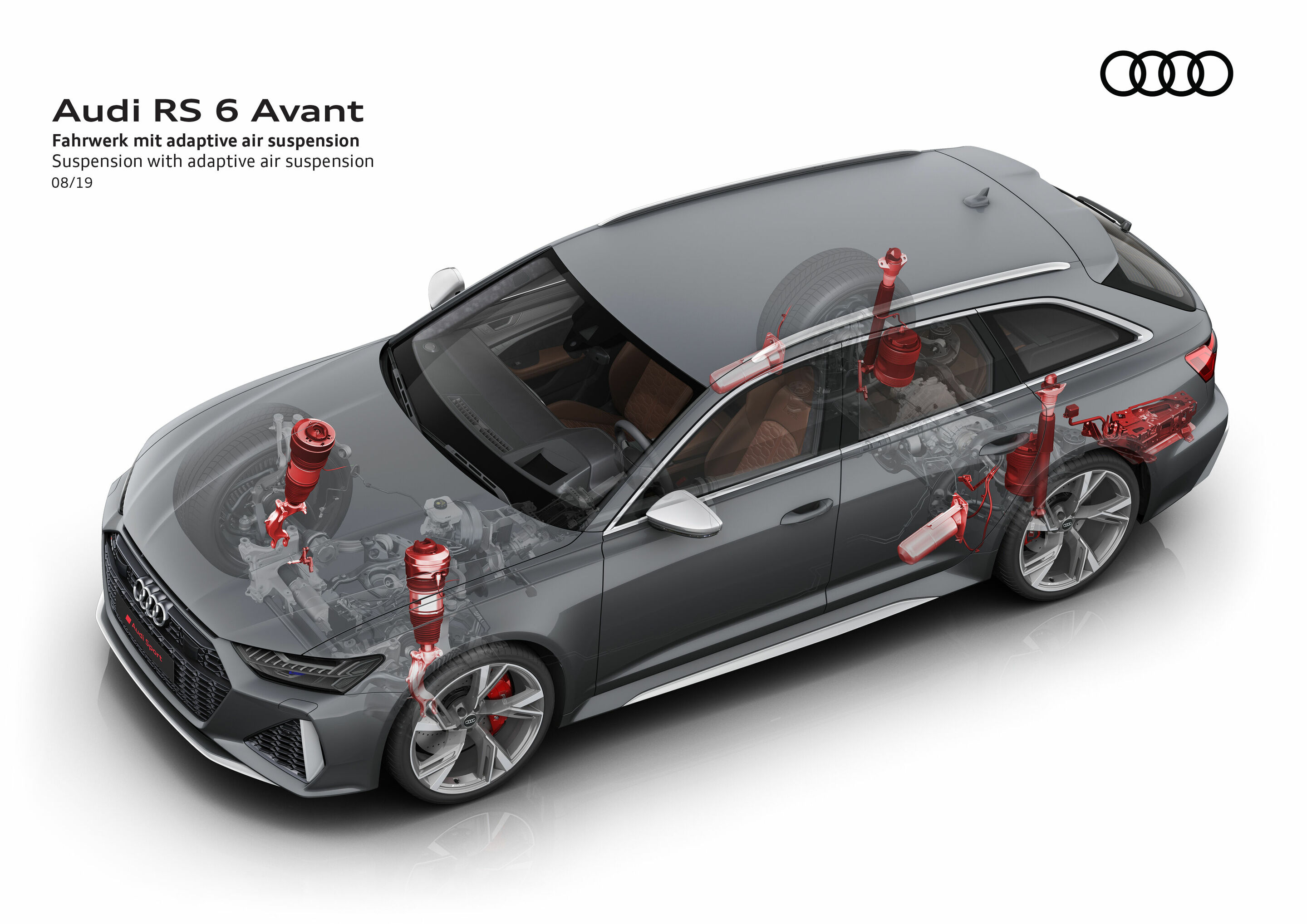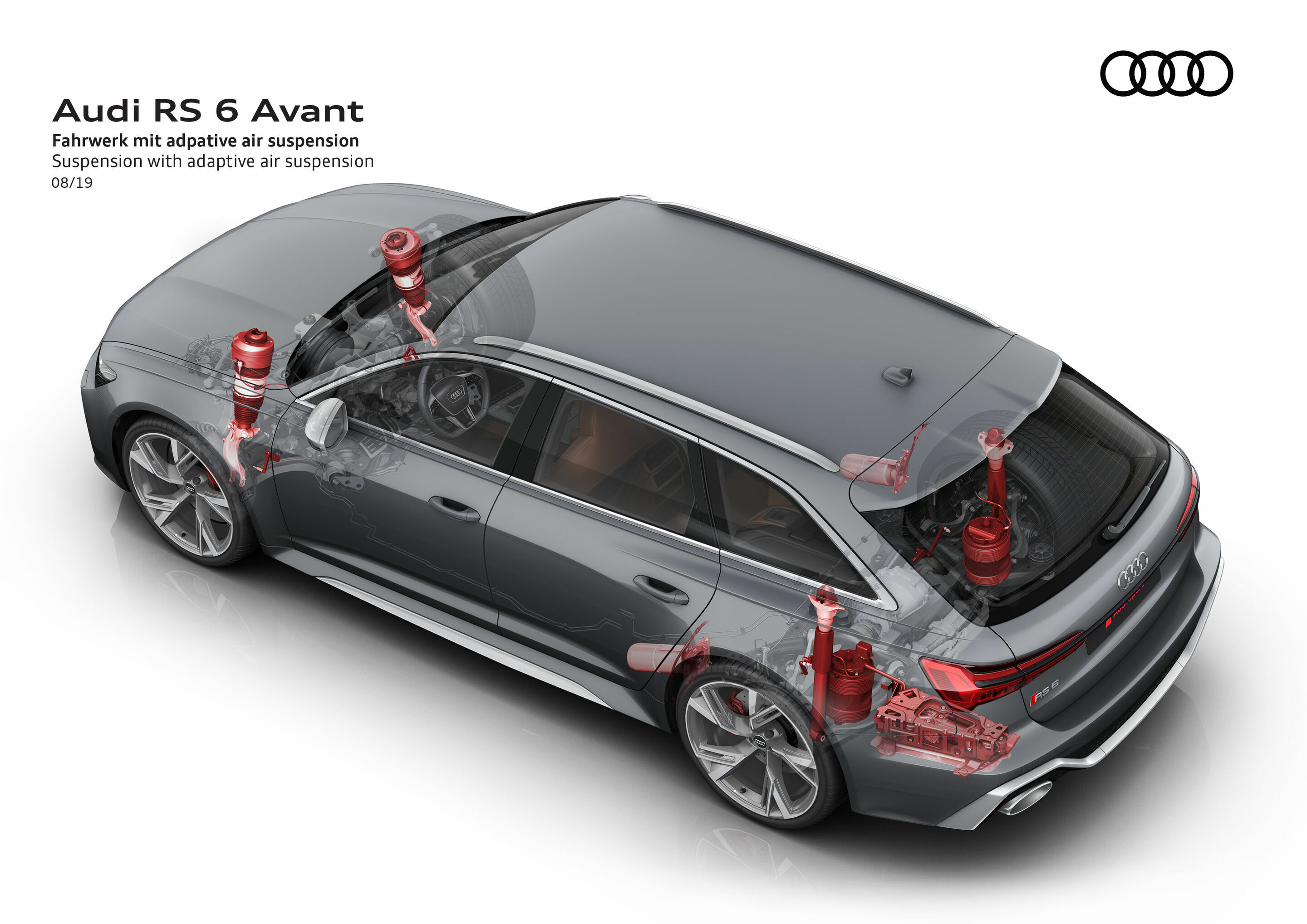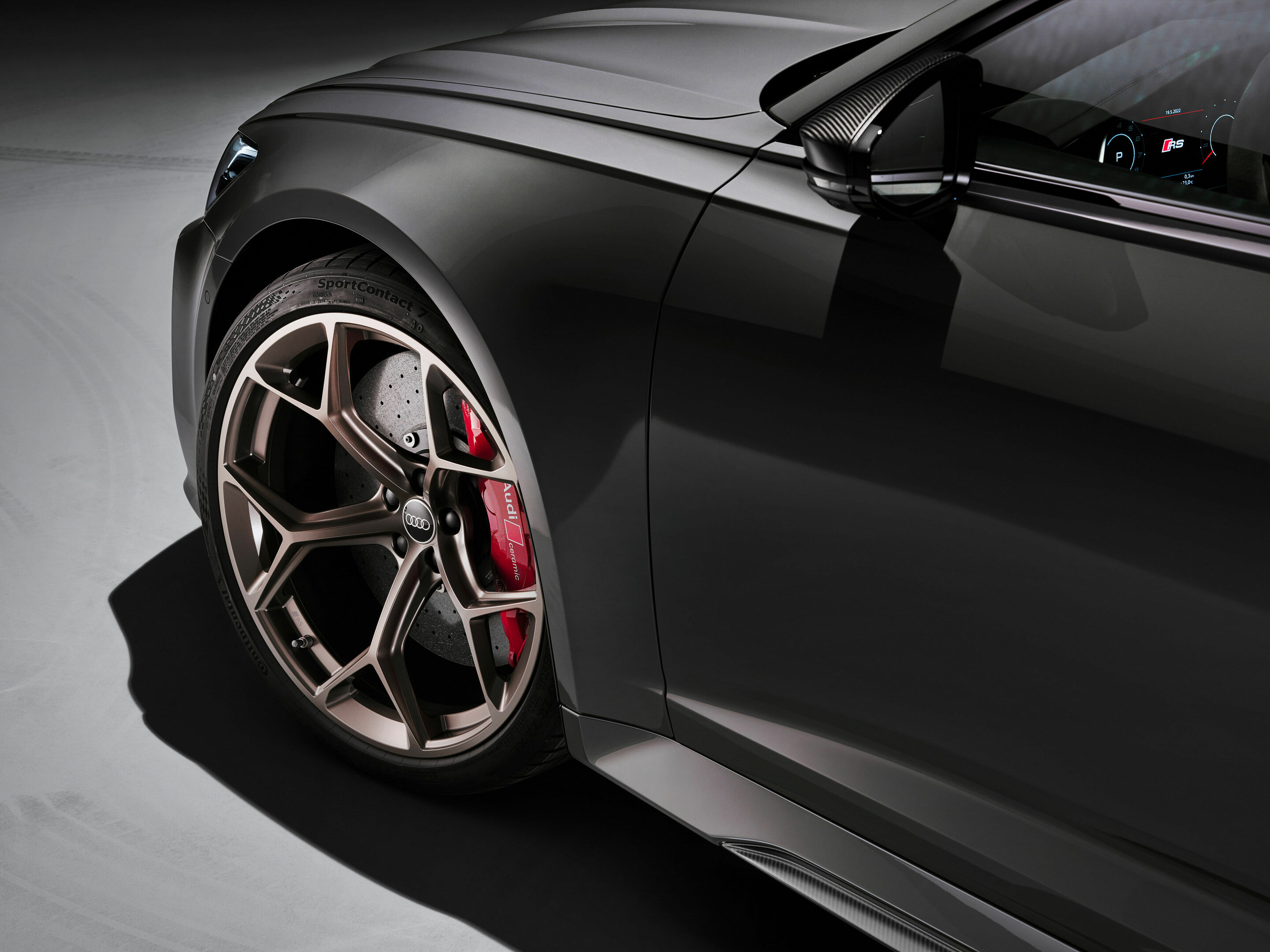On the Audi RS 6 Avant and Audi RS 6 Avant performance, the front and rear axles use a five-link design to handle the induced longitudinal and transverse forces separately. The linkages and the subframes are made largely of aluminum. The track width is 1,668 millimeters (5.5 ft) at the front and 1,650 millimeters (5.4 ft) at the rear.
The standard RS adaptive air suspension with controlled damping has been tuned specifically to suit the RS and now allows the RS 6 Avant and RS 6 Avant performance to reach a top speed of 305 km/h (189.5 mph) thanks to an air spring module with a 50% higher spring rate (with the dynamic plus package). It can be set to several modes and includes automatic level control. The electronic chassis platform (ECP) acts as the central control mechanism that regulates the way in which the dampers work to suit the road condition, the driver’s personal driving style, and the Audi drive select mode currently enabled. The air suspension also includes automatic level control.
In the normal position in auto, comfort, and efficiency modes, the body of the RS 6 Avant and RS 6 Avant performance sit 20 millimeters (0.8 in) lower with both types of suspension than an A6 Avant with standard suspension. At speeds of 120 km/h (74.6 mph) and above, the air suspension lowers itself by another 10 millimeters (0.4 in) in the three modes specified above. In dynamic mode, the body remains at this low ride height permanently.
On poor road surfaces, the RS adaptive air suspension features a lift that can raise the RS 6 Avant and RS 6 Avant performance by 20 millimeters (0.8 in) above its normal level at low speeds. The very wide spread of the RS adaptive air suspension offers the driver a free choice between long-distance comfort and maximum performance.
The RS sport suspension plus with Dynamic Ride Control (DRC) is available as an alternative. It lets the RS 6 Avant and the RS 6 Avant performance hug the road even more tightly and further improves handling. Dynamic Ride Control offers integrated pitch and roll stabilization consisting of steel springs and three-way adjustable dampers that counteract the movements of the vehicle body with no delay, without the use of electronics. When the vehicle is turning into and traveling around a bend, the damper response is altered so that the vehicle’s movements on the longitudinal axis (roll) and the transverse axis (pitch) are significantly reduced. The dampers are each connected diagonally to a central valve via two separate oil lines. The valves provide the necessary compensating volume via internal pistons with the gas-filled compartment behind them. When the vehicle is steering into and traveling around a bend, an oil flow is generated between the diagonally opposite dampers via the central valve, thereby creating additional damping force.
When one side is cushioned, the damping characteristics are altered such that roll and pitch movements are eliminated almost entirely. As a result, this highly responsive damper system ensures that the high-performance Avant is particularly precise when negotiating bends.
The generation of dampers with integrated valve has a more compact, lighter design and reduces pitch and rolling movements even more effectively. In addition, it enables the damping forces to be spread even more widely between the comfort, auto, and dynamic modes as well as more precise suspension adjustment for high damping forces, which occur during cornering at speed.
The result: In comfort mode, the RS sport suspension with Dynamic Ride Control (DRC) ensures amazing ride comfort. In the dynamic program, it delivers extraordinary driving precision even when cornering at high speed.
With the aid of the Audi drive select dynamic handling system, the driver can influence the damper characteristics and thereby personalize the driving experience.
The RS 6 Avant and the RS 6 Avant performance are fitted with progressive steering with a sporty and direct ratio as standard. Its specially designed gear rack varies the ratio depending on the steering angle in a range from 12.6 : 1 to 15.8 : 1. As steering wheel turn increases, the ratio decreases, and the steering becomes more direct. This reduces steering effort in urban traffic and when maneuvering; in tight curves the car is even more agile. Here, progressive steering provides for sporty handling.
| RS dynamic package | Top speed increased to 280 km/h (174.0 mph) |
| | Dynamic all-wheel steering tuned specifically for the RS |
| | quattro sport differential |
| RS dynamic plus package | Top speed boosted to 305 km/h (189.5 mph) |
| | Dynamic all-wheel steering tuned specifically for the RS |
| | quattro sport differential |
| | RS ceramic brake system |
It also adjusts the power assistance level as a function of driving speed. It is increased at low speeds for easier maneuverability. The character of the power steering can be varied via the modes of the Audi drive select dynamic handling system.
The RS 6 Avant can be equipped with dynamic all-wheel steering as an option. It combines direct, sporty steering response with unshakable stability, resolving an age-old conflict of objectives. At the front axle, dynamic steering features strain wave gearing with a ratio that changes depending on the situation. The combination of dynamic steering and rear-axle steering changes the overall steering ratio within a range of 9.5 to 17.0 – from very direct at low speeds to extremely stable at high speeds. This steering system also ensures that the rear wheels turn a few degrees in the same or opposite direction relative to the front wheels depending on the vehicle’s speed. At low speeds, the rear wheels turn as much as five degrees in the opposite direction relative to the front wheels. This reduces the turning circle by up to one meter (3.3 ft).Thus, the RS 6 Avant and RS 6 Avant performance are even more agile in curves. At intermediate and high speeds above around 100 km/h (62.1 mph), the rear wheels follow the movement of the front wheels by up to two degrees. The RS 6 Avant and RS 6 Avant performance thereby gains more stability, dynamism, and driving safety.
RS Dynamic Package as standard in the RS 6 Avant performance
The RS Dynamic Package is standard equipment in the RS performance. This includes the increase in maximum speed to 280 km/h (180 mph), dynamic all-wheel steering (the RS-specific software update helps the driver with active steering corrections on the front and rear axles), and the quattro sport differential on the rear axle.
The RS Dynamics Package plus is also available as an option, which in addition to the RS Dynamics Package, raises the top speed to 305 km/h (189.5 mph) and includes an RS ceramic brake system.
“RS MODE”: a button for vehicle dynamics
With the Audi drive select dynamic handling system, the driver can influence the characteristics of both steering variants as well as other aspects of the RS 6 Avant and RS 6 Avant performance. There are six profiles available: efficiency, comfort, auto, dynamic, as well as two customizable RS-specific RS1 and RS2 modes. Once these have been set to suit the driver’s personal preferences and stored in the MMI touch response, they can be enabled directly via quick access to the RS MODE button on the steering wheel. Consequently, the driver can easily switch between the RS1, RS2, and last selected drive select modes without having to operate the MMI touch response again.
The Audi drive select system influences the engine and transmission management, the power steering, the suspension, the dynamic all-wheel steering, the quattro sport differential, the engine sound, and the way in which the automatic air conditioning works. In RS2 mode, customers can also switch the Electronic Stabilization Control (ESC) to sport mode at the touch of a button and save this setting permanently. If the driver presses the ESP button for more than three seconds, the Electronic Stabilization Control is deactivated completely.
But the experience of the driving modes in the performance model is much more unique. For example, the coasting mode now only activates automatically in the efficiency profile, which means in speed ranges up to 160 km/h (99.4 mph), it switches off the combustion engine and coasts with no fuel consumption or drag torque from the engine. Additionally, fine-tuning to the engine control unit software makes for tighter load changes in S mode when the dynamic drive select mode or driving mode S is active, further increasing the emotionality. The updated software in the transmission control unit makes for faster shifting times and a noticeably increased spread between the various driving modes.
Exclusive and highly performing: the wheel program
The RS 6 Avant is fitted as standard with 21-inch cast aluminum wheels in 10-spoke star design, which are shod with 275/35 size tires. Audi Sport GmbH is offering an RS-specific wheel in 22-inch 5-V-spoke trapezoid design with 285/30 tires as an option, in a choice of silver, matte titanium look, and glossy anthracite black. At the front axle of the high-performance Avant, a ten-piston fixed-caliper brake system delivers outstanding performance and high stability.
The calipers of the standard RS brake system with internally ventilated and perforated discs (measuring 420 millimeters (16.5 in) at the front and 370 millimeters (14.6 in) at the rear) are painted black, with red available upon request.
On the optional and RS ceramic brake system, the calipers can be gray, red, or blue. The discs measure 440 millimeters (17.3 in) at the front and 370 millimeters (14.6 in) at the rear. The anthracite gray ceramic discs are extremely stable, powerful, and long-lasting. Two air deflector elements attached to the front axle on each side quickly dissipate the heat and improve fading stability. The RS ceramic brake system weighs 34 kilograms (75 lb) less than its steel counterpart. This reduces the unsprung masses and represents a further advantage in terms of light-footed handling.
22-inch wheels with high-performance tires for the performance version
The new RS 6 Avant performance roll off the line on standard 21-inch aluminum cast wheels in a ten-spoke star design and 275/35 tires. For an even sportier appearance, 22-inch lightweight wheels are also available, alongside the standard 22-inch aluminum cast wheels – in burnished glossy metallic black, matte gray, matte black, or matte neodymium gold. Inspired by motorsport, the airy 5-Y spoke design aids brake cooling, and the lighter rims are manufactured in a high-tech forging-milling process. The new lightweight wheel is around five kilograms (11 lb) lighter than the 22-inch aluminum wheel on the current RS 6 Avant – this 20-kilogram (44.1 lb) weight reduction in unsprung masses improves the throttle response.
New high-performance Continental “Sport Contact 7” 285/30 tires, which are part of the new lightweight wheel, play a key role in reducing weight. The tires offer consistently better grip on both dry and wet roads and reduce understeering when cornering at speed, making for overall more precise handling across the entire speed range. Additionally, the brake path is up to two meters shorter with the new wheels when braking from 100 to 0 km/h (62.1 to 0 mph).
All terms marked in the text are explained in detail in the technology lexicon at www.audi-mediacenter.com/en/technology-lexicon.
The equipment, data and prices specified in this document refer to the model range offered in Germany. Subject to change without notice; errors and omissions excepted.



